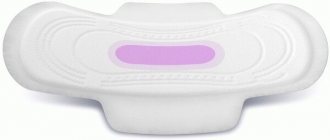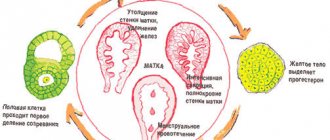Calculate your cycle using a menstrual calendar
A menstrual calendar is something that every girl should definitely keep, regardless of whether she is sexually active or not. Depending on how regularly menstruation occurs, one can judge the general state of health, not only the reproductive system. For example, irregular periods may be associated with problems in the endocrine system or too low body weight. Only a doctor can determine the exact cause of this phenomenon.
Any girl can calculate her period calendar. Ideally, the cycle lasts no less than 25 and no more than 35 days, more often - 28-30. Other options require a medical examination. An important point is that the menstrual cycle is counted from the very first day of menstruation until the first day of the next one. So when your doctor asks the question, “When was your last period?”, you need to say the first day of your last period. For a healthy woman, her period comes exactly after a certain period of time. Our online menstruation calendar will help you remember about the onset of the next critical days. You only need to correctly indicate the first day of your last menstrual bleeding and the length of your cycle.
For most women, the main role of the calendar is not to track the possible onset of pregnancy (noticing a delay in time). The menstrual calendar also allows you to calculate the days of ovulation - when pregnancy is most likely to occur during unprotected sexual intercourse. These days occur in the middle of the menstrual cycle. The beginning of the cycle and its end are considered “sterile.” However, there are many cases where women became pregnant even at “safe” times, and therefore it is not worth using only the calendar method as contraception. It is better to keep a record of dangerous and safe days for planning pregnancy, and not for protecting against it.
Another interesting option for using an online period calendar is to plan the gender of your child. It is known that conception that occurs exactly in the middle of the cycle usually gives a boy, and 1-2 days before ovulation - a girl. It is believed that this statistics is due to better motility of sperm - carriers of the male chromosome. Future girls are not so nimble, but more resilient and patient, and can remain viable in the female genital tract for up to several days.
An online menstrual calendar will help expectant mothers calculate their due date. The average duration of pregnancy for women is 280 lunar days. You can add 280 to the probable date of conception (the day of ovulation, as a rule) and thus find out the expected date of birth. An easier way is to use the Naegele formula - subtract 3 months from the first day of the last menstruation and add 7 days. However, this formula may give erroneous results for women with irregular, too long or, conversely, short menstrual cycles. With a long cycle, ovulation occurs later, which means the pregnancy lasts longer, so to speak. But with a short birth, on the contrary, a woman can give birth a little earlier than the due date. The date of birth of a child is influenced by many factors. Even at the date confirmed by several methods, not even half of the babies are born.
When can you consider your period to be over?
26.04.2018
Women are not always able to immediately understand that their periods have ended. The end of the next regulations does not happen instantly.
Often, heavy discharge is replaced by a slight spotting that lasts several hours or days. An equally important point is the onset of menopause.
Every representative of the fairer sex should be able to recognize the symptoms of menopause and understand that reproductive function has begun to fade.
Menstrual cycle and menopause
The menstrual cycle in women of reproductive age occurs in several main stages:
- egg maturation;
- release of the fertilized egg from the follicle (ovulation);
- endometrial proliferation;
- death of the egg and rejection of the endometrium in the absence of fertilization. During this period, the arrival of menstrual flow is noted.
All these processes are regulated by the hormones estrogen and progesterone in women at puberty. Such changes are observed monthly. The duration of the cycle can vary from 21 to 35 days.
Over time, reproductive function begins to fade. This process is caused by hormonal changes and the gradual cessation of the production of sex hormones. This period is called menopause. As a result of such changes in the body, menstruation ends and menopause occurs.
When to expect menopause
At a certain stage in women's lives, the process of biological aging begins. It is characterized by a decrease in reproductive function, hormonal changes and the impossibility of fertilization. Such changes occur over several years and are called menopause. It occurs in several stages:
- Premenopause. This condition is observed at the age of 40–45 years. In this case, the functions of the ovaries are gradually suppressed. These paired organs are responsible for the production of estrogen, which is necessary for the maturation of the fertilized egg. The concentration of the hormone gradually decreases, after which its production stops. The duration of perimenopause varies from 2 to 10 years.
- Menopause. This period begins a year after the cessation of menstrual flow.
- Postmenopause. The appendages stop functioning as they should, estrogen is not produced, and the number of genetically stored eggs runs out.
As a rule, critical days during menopause stop at the age of 49–52 years. A woman reaches menopause after a year. However, not a single doctor can name the exact age at which menopause will begin. This process is influenced by many factors, including heredity, health status, bad habits and lifestyle.
Biological aging can begin earlier or later than expected. Often, the decline of reproductive function at the age of 50–60 years is observed in the presence of malignant tumors.
Symptoms of menopause
The first symptoms of menopause begin to appear long before the complete cessation of menstrual flow. Therefore, it is so important for women to understand what changes are occurring in their body.
The following clinical manifestations are noted:
- cycle failure. Critical days become irregular, prolonged, the nature of discharge and the volume of blood lost changes. This period lasts about a year, after which the regulations are no longer observed;
- tides. In this condition, a feeling of heat appears, changes in body temperature, excessive sweating, and pressure changes are observed, which are accompanied by disturbances in heart rhythm. Such sensations are observed for 5–15 minutes, after which they disappear as suddenly as they appeared;
- dryness in the genital area. In this case, a woman may experience pain during intimacy. Itching and burning may also occur;
- disorders of the urinary system. Menopause is often accompanied by inflammatory processes in the urinary tract and bladder. Problems during urination cannot be ruled out;
- change in psycho-emotional state. Symptoms such as irritability, nervousness, depression, sleep disturbances, memory problems and frequent headaches are noted;
- lack of sexual desire;
- laxity of the skin and hair loss;
- increase in body weight.
How to count your menstrual cycle. Reasons for deviations from the norm
The nature of menstruation and its regularity are important indicators of women's reproductive health. The body reacts sensitively to any stress, so occasional deviations from the norm are possible, which are not considered pathology. However, if the disturbances are persistent, this may indicate a disease. It is convenient to mark the start and end days of menstruation on a calendar. This will allow you to find out the duration of the next cycle and not miss unusual changes. It is important to understand what processes occur between menstruation, when conception is possible, and why critical days occur more often or less frequently than usual.
- Why does the cycle lengthen?
Why is cycle duration calculated?
Processes in the female reproductive organs are repeated every month, on average after 28 days. Due to the individual characteristics of the body, the cycle can be shorter (up to 21 days) or longer (up to 35 days). The main indicator of health is not so much the number of days in it, but the constancy of this indicator. If a woman gets her period regularly after 5 weeks or after 3 weeks, this is normal. But if they occur either after 35-40 days, or after 20-21, and this happens repeatedly, this is already a pathology.
Knowing her menstrual cycle and how to count it, a woman can:
- Prepare for the onset of menstruation, take measures to alleviate premenstrual syndrome (plan, for example, the load during critical days).
- Provide for the possibility of pregnancy in the middle of the cycle, increase attention to contraception.
- Take into account which days will be most favorable for conception and the onset of the planned pregnancy.
- Notice the onset of pregnancy and approximately calculate the day of birth.
- Plan a preventive visit to medical specialists (gynecologist, mammologist).
Having noticed persistent irregularities in the frequency of menstruation, it is necessary to consult a doctor in time to prevent early menopause or the occurrence of diseases of the uterus and ovaries.
Menopause: when menstruation ends forever
For every woman, there will come a time when menstruation stops and menopause arrives. Many representatives of the fair sex have heard about it, many have read, and many know from their female ancestors how this happens.
But, let’s figure out what the essence of this terrible “monster” called menopause is. Maybe “the devil is not as scary as he is painted”?
What processes occur during the menstrual cycle
The processes occurring in the female reproductive system are directly related to the ratio of sex hormones that are produced in the ovaries. The cycle is conventionally divided into phases: follicular, in which the maturation of the egg occurs, ovulatory and luteal - the phase of the onset and maintenance of pregnancy.
Follicular phase
The beginning is considered the first day of menstruation. Its duration in different women ranges from 7 to 22 days (the duration of this particular phase determines whether a woman’s cycle is short or long). The phase begins with menstruation - the cleansing of the uterus from the endometrial layer that formed earlier. Menstruation occurs when fertilization of the egg does not occur.
By the end of menstruation, the pituitary gland begins to produce follicle-stimulating hormone, under the influence of which several follicles (vesicles with eggs) develop in the ovaries. Of these, one stands out, the largest (dominant), which grows to approximately 20 mm in diameter. The growth of the rest stops.
During the development of follicles, estrogens are intensively released, due to which a new layer of mucous membrane (endometrium) begins to grow in the uterus.
Ovulation
The follicle (the so-called Graafian vesicle) that has matured along with the egg bursts on days 7-22 (on average 14) of the cycle. At the same time, the hormone lutein is released from the pituitary gland, which promotes the formation of the corpus luteum from the ruptured membrane. Its purpose is to produce progesterone, which prevents the development of new follicles. Ovulation and progesterone production usually continues for 16-48 hours.
Facts about “these” days: What are they? How long? How strong?
What does menstrual flow consist of?
During menstruation, fluid is released from the vagina, which, contrary to popular belief, consists of more than just blood. It also contains clear mucus and desquamated epithelium of the uterine mucosa. The color of menstrual discharge can change. It depends on how much blood is contained in the discharge and is determined by the day of the menstrual cycle. On the first day of your period, you may notice bright red discharge, and on the last day it will turn brownish or even dark chocolate brown.
How long does the first period last?
It is impossible to say exactly how long your first period lasts. For each girl, the period of menstruation is individual. It is also impossible to predict how long your subsequent periods will last. They can last from three to seven days. The norm for menstruation, as well as a strictly defined cycle, simply does not exist.
How much blood does a girl lose during her period?
Just like all other features of the menstrual cycle, the intensity of discharge from the female body varies greatly. The average volume of blood lost by a girl during her period is approximately 65 ml, that is, less than half a regular glass. Not so much, right?
Causes of menstrual irregularities
In addition to fluctuations in the timing of menstruation, menstrual disorders also include the duration of menstruation less than 3 or more than 7 days, changes in the intensity of blood discharge (less than 40 ml or more than 80 ml on all days), and lack of ovulation.
The causes of violations may be:
- Diseases of the reproductive and endocrine organs. You need to know how to count your menstrual cycle so as not to miss the onset of the disease.
- Hormonal changes during natural age-related changes (maturation, menopause). During puberty, the maturation of the ovaries is just beginning, so in the first 2 years, girls’ periods may be delayed by 2-6 months. Often, ovarian maturation is completed only during the first pregnancy. For many women, the cycle stabilizes after childbirth.
- Physiological processes during the recovery period of the body after pregnancy and childbirth, during lactation.
- Hormonal imbalances after abortion.
- Hormone imbalance caused by stress, medication, sudden weight loss or weight gain.
The older a woman is, the greater the likelihood of disorders occurring, as possible causes accumulate (number of births, abortions, consequences of gynecological and other diseases), and the body ages.
Why does the cycle lengthen?
The reason for the increase in cycle length may be the lack of ovulation due to inadequate development of follicles. In this case, the corpus luteum does not form and progesterone levels do not increase. Under such conditions, under the influence of estrogens, the endometrium continues to grow until it begins to break down mechanically. In this case, the onset of menstruation is significantly delayed.
Another reason for the lengthening of the cycle may be the existence of the corpus luteum for too long after pregnancy has not occurred. This anomaly is determined using ultrasound.
Addition: The opposite situation is also possible. A woman experiences a delay in her period due to the onset of pregnancy, but when she comes to be checked by a gynecologist, it turns out that there is no corpus luteum in the ovaries, although it should be there and provide nutrition to the embryo. This indicates a threat of miscarriage. Special treatment with hormones is required.
Reasons for shortening the cycle
The cycle is shortened due to the fact that the corpus luteum dies earlier than usual, or follicle maturation and ovulation occur faster.
Often, deviations in the duration of the cycle are the body’s response to the occurrence of extreme living conditions, when, for health reasons or due to a difficult life situation, bearing healthy offspring is impossible. For example, during the war, women lost their periods altogether.
Video: Duration of the menstrual cycle. Reasons for deviations
When to expect menopause
The age at which menstruation stops varies from person to person. World statistics show that the average period ranges from 45 to 55 years, and five percent of women continue to have periods even after 55.
There are cases in history where menstruation continued even at the age of 60, but this is more of a unique case than a regular one. It is clear that at the age of 55 the cycle becomes irregular, scarce, and conceiving a child becomes almost impossible.
For some female representatives, menopause begins at the age of 40; more precisely, every eighth woman on the planet has early menopause.
In nature, there are three periods of menopause:
- Premenopause (premenopausal). Comes after 40 years. Menstruation occurs during the premenopausal period, but for the most part without the formation of an egg. It turns out that they no longer seem to have their periods fully, because they pass without ovulation. The general hormonal balance is disrupted and there is a high probability of gaining extra pounds (5-10 kg) during this period. The changes also affect the condition of the skin: the number of wrinkles increases, the elasticity of the epidermis is lost. A woman's sexual activity decreases. The premenopausal period lasts from 1 to 10 years.
How is cycle time calculated?
The countdown starts from the first day of menstruation. And it ends on the last day before the next menstruation. How to correctly calculate the menstrual cycle, taking into account the different number of days in each month, can be seen in examples.
Example 1. A woman had her previous menstruation on March 5, and the next one came on April 2. The duration of the cycle is 27 (the number of days starting from March 5 and ending on March 31) + 1 day (April 1) = 28 days.
Example 2. The previous menstruation was on September 16, the next one on October 14. The duration of the cycle is: 15 (from September 16 to 30) + 13 (in October) = 28 days.
Will periods always be the same?
Your menstrual cycle can change as your body grows and develops. The cycle may also become longer or shorter. Most women notice certain changes in the intensity, timing and duration of their periods. As a rule, they are most irregular in young girls and in some women before menopause. The regularity of your cycle may change due to the use of birth control pills. Today there are many different pads and tampons of all sizes. Each of these products provides a certain level of protection. You can find tampons that meet the needs of girls who have just started menstruating here.
How to calculate your menstrual cycle (Calculator)
Menstruation (regular or monthly) affects the psycho-emotional and physical state of a woman; on certain days the likelihood of conception increases, which helps plan pregnancy. Every girl needs to know how to count her menstrual cycle. The calendar or our online calculator will help you make accurate calculations.
You can calculate your menstrual cycle using a regular calendar or special online calculators
Why do you need to know your menstrual cycle?
The interval between regulations in a healthy woman of reproductive age is cyclical and has a certain duration. But sometimes various failures occur, the breaks between menstruation increase or decrease, with correct and regular calculations, you can prepare in advance for the arrival of critical days.
Why do you need to know when your period arrives?
- Knowing the frequency of the onset of menstruation, you can plan important events and prepare the necessary hygiene products in advance.
- The schedule allows you to notice deviations in time and contact a gynecologist in a timely manner - any disease is easier to cure at the initial stage of development.
- It is easier to plan a pregnancy, or find out about conception if your period is late.
- Track the time when PMS appears - for many women this period is difficult, it is necessary to take painkillers or sedatives, it is better to prepare in advance.
Calculating your menstrual cycle makes it easier to plan a pregnancy
Symptoms of menopause
Any woman, by her nature, is unique, therefore the “bouquet” of first signs will be different and unique. Sometimes during reproductive age a woman seems to feel the symptoms of approaching menopause. But this could be amenorrhea - a menstrual disorder in which menstruation does not occur.
In rare cases, menopause occurs at 30–35 years of age, but this is not a pattern, but an exception to the rule.
All symptoms of menopause are divided into:
- Early (premenopausal phase);
- Average (menopause);
- And, late (postmenopausal phase).
We will try to consider the most complete list of possible first signs of menopause:
1. Early:
- The most common symptom of the oncoming menopause is a disruption of the menstrual cycle. They can go whenever they want. They can be abundant or scanty. The interval between menstruation increases, and over time, the critical days end forever.
- Tides. This is a sudden increase in temperature in the upper parts of the body: face, neck, chest.
- Sweating. Occurs as a consequence of hot flashes. May be profuse, in the form of perspiration on the body.
- Sudden chills that are not natural phenomena.
- Insomnia.
- Drowsiness, lethargy, weakness throughout the day - all this occurs due to insomnia. Often such conditions can lead a woman to depression.
- The early stage also affects pressure changes, and the heart rate may increase.
- Due to poor health and lack of sleep, a woman becomes irritable and aggressive.
- Sexual desire decreases or disappears.
- The woman becomes dissatisfied with her life, headaches and migraines appear. As a result, all of the above often fails.
2. The middle stage implies the following signs:
- The internal mucous membranes reduce the abundance of secretions, which causes dryness and burning of the genitals. This all happens due to low amounts of progesterone and estrogen.
- Pain occurs during sex because the amount of lubrication in the vagina decreases.
- Wrinkles, dry skin, loss of elasticity, brittle nails, hair loss - this is the aging of the body.
- Frequent urge to go to the toilet, urinary incontinence as a result of hormonal imbalance and low immunity.
3. Late period:
- Osteoporosis is a bone disease.
- Disease of the heart and blood vessels.
- Vein disease.
- Loss of the ability to remember new knowledge and skills. This applies to older (senile) age.
If a woman experiences several of the above symptoms and is over 40 years old, it is recommended not to make a diagnosis on her own, but to consult a specialist. A gynecologist will help you cope with your body as best as possible.
How to correctly count your menstrual cycle
What day is your cycle counted from? To calculate the cyclicity of the arrival of critical days, you need to use several dates. Specially developed methods will help you avoid getting confused in the calculations.
Online calculator for calculating your menstrual cycle
Calendar calculation method
To correctly calculate the duration of the intervals between menstruation, the first day of the appearance of discharge and the date before the start of the next menstruation are noted on the calendar; observations are carried out for 3–12 months.
Examples:
- The start date of menstruation is 6.05, the next one is 06. Calculation: 31 (number of days in May) – 6 (day of the start of the period) +3 =28. The next critical days should occur on July 1st.
- If over several months the calculation showed fluctuations of 1–3 days, then the duration of the intervals between menstruation is the average value of 3 indicators. For example: (27+25+29) : 3=27.
- If during the year all the intervals between the regulations are approximately the same, and one month stands out greatly from the overall picture, you can not take its duration into account when calculating the average indicators - such a failure may be associated with stress or climate change.
- If the duration of the intervals between critical days is more than 30 days, the time of their occurrence will shift monthly by several days, if the intervals are less than 30 days - by several days ago.
- On the calendar you need to mark the number of days when spotting appeared and when your period ended, usually 3-7 days. With regular charting, you can calculate not only the start date of menstruation, but also its end.
Knowing the number of days in your cycle, you can easily predict the dates of menstruation and days of possible fertilization
Normal menstrual cycle
Previously, it was considered normal if the duration of the intervals between regulations was 28 days, but now deviations up and down are allowed. The cycle must last at least 21 days, the maximum cycle duration is 35 days, permissible deviations are 1–3 days.
Knowing the date of arrival of your critical days, you can plan a pregnancy or, conversely, avoid unwanted conception in a certain period of time. Keeping records is not difficult; all you need is a simple calendar and a pen, or a special online calculator; it is important to record all values correctly and systematically.
Sources:
https://www.missfit.ru/kalendar-mesyachnyh-rasschitat-onlain/ https://prosto-mariya.ru/kak-schitat-cikl-mesyachnyh-prichiny-otklonenij-ot-normy_1642.html https://lechusdoma .ru/kak-poschitat-tsikl-mesyachnyh/











